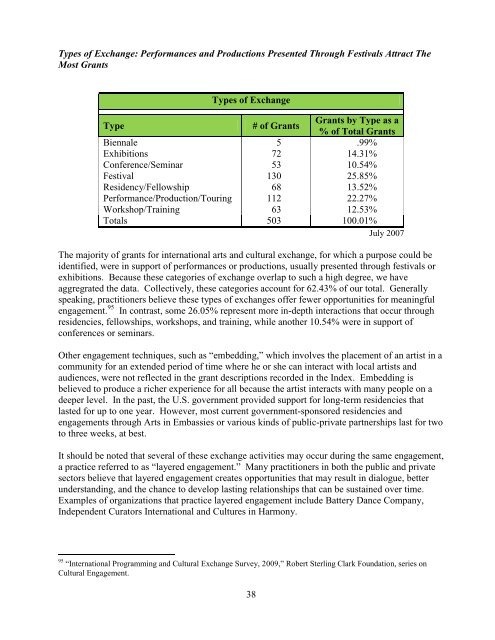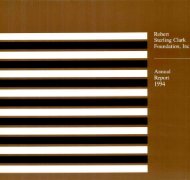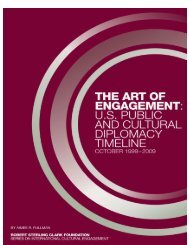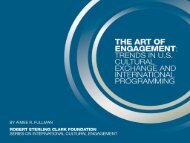Types of <strong>Exchange</strong>: Performances <strong>and</strong> Productions Presented Through Festivals Attract TheMost GrantsTypes of <strong>Exchange</strong>Type# of GrantsGrants by Type as a% of Total GrantsBiennale 5 .99%Exhibitions 72 14.31%Conference/Sem<strong>in</strong>ar 53 10.54%Festival 130 25.85%Residency/Fellowship 68 13.52%Performance/Production/Tour<strong>in</strong>g 112 22.27%Workshop/Tra<strong>in</strong><strong>in</strong>g 63 12.53%Totals 503 100.01%July 2007The majority of grants for <strong>in</strong>ternational arts <strong>and</strong> cultural exchange, for which a purpose could beidentified, were <strong>in</strong> support of performances or productions, usually presented through festivals orexhibitions. Because these categories of exchange overlap to such a high degree, we haveaggregrated the data. Collectively, these categories account for 62.43% of our total. Generallyspeak<strong>in</strong>g, practitioners believe these types of exchanges offer fewer opportunities for mean<strong>in</strong>gfulengagement. 95 In contrast, some 26.05% represent more <strong>in</strong>-depth <strong>in</strong>teractions that occur throughresidencies, fellowships, workshops, <strong>and</strong> tra<strong>in</strong><strong>in</strong>g, while another 10.54% were <strong>in</strong> support ofconferences or sem<strong>in</strong>ars.Other engagement techniques, such as ―embedd<strong>in</strong>g,‖ which <strong>in</strong>volves the placement of an artist <strong>in</strong> acommunity for an extended period of time where he or she can <strong>in</strong>teract with local artists <strong>and</strong>audiences, were not reflected <strong>in</strong> the grant descriptions recorded <strong>in</strong> the Index. Embedd<strong>in</strong>g isbelieved to produce a richer experience for all because the artist <strong>in</strong>teracts with many people on adeeper level. In the past, the U.S. government provided support for long-term residencies thatlasted for up to one year. However, most current government-sponsored residencies <strong>and</strong>engagements through Arts <strong>in</strong> Embassies or various k<strong>in</strong>ds of public-private partnerships last for twoto three weeks, at best.It should be noted that several of these exchange activities may occur dur<strong>in</strong>g the same engagement,a practice referred to as ―layered engagement.‖ Many practitioners <strong>in</strong> both the public <strong>and</strong> privatesectors believe that layered engagement creates opportunities that may result <strong>in</strong> dialogue, betterunderst<strong>and</strong><strong>in</strong>g, <strong>and</strong> the chance to develop last<strong>in</strong>g relationships that can be susta<strong>in</strong>ed over time.Examples of organizations that practice layered engagement <strong>in</strong>clude Battery Dance Company,Independent Curators International <strong>and</strong> Cultures <strong>in</strong> Harmony.95 ―International Programm<strong>in</strong>g <strong>and</strong> <strong>Cultural</strong> <strong>Exchange</strong> Survey, 2009,‖ Robert Sterl<strong>in</strong>g Clark Foundation, series on<strong>Cultural</strong> Engagement.38
Size of Recipients: Larger <strong>and</strong> More Established Organizations Comm<strong>and</strong> the Greatest ShareMillion Dollar Recipients of Support for DirectInternational Arts <strong>Exchange</strong>, 2003-2008Rank Rank# ofby $ by # Recipient NameGrants Amount <strong>in</strong> $1 2 Asia Society, NY Total, 2003-2008 33 $11,431,0002 27 National Gallery of Art Total, 2003-2008 6 $5,717,0003 9 Asian <strong>Cultural</strong> Council Total, 2003-2008 12 $4,230,0004 213 National Performance Network Total, 2003-2008 1 $3,527,1865 43 WONDERS: The Memphis International <strong>Cultural</strong> Series5 $3,150,000Total, 2003-20086 28 Sundance Institute Total, 2003-2008 6 $3,105,0007 60 Blakemore Foundation Total, 2003-2008 4 $3,000,0008 6 Russian Arts Foundation Total, 2003-2008 14 $2,591,5509 85 Institute of International Education Total, 2003-2008 3 $2,490,95510 7 Ch<strong>in</strong>a Institute <strong>in</strong> America Total, 2003-2008 13 $2,320,77611 1 CEC ArtsL<strong>in</strong>k Total, 2003-2008 55 $2,268,70012 3 French American <strong>Cultural</strong> <strong>Exchange</strong> Total, 2003-2008 24 $1,575,00013 29 Museum of New Mexico Foundation Total, 2003-2008 6 $1,471,00014 10 Center for International Theater Development Total, 2003-2008 11 $1,400,00015 22 Theater Communications Group Total, 2003-2008 7 $1,280,00016 118 Solomon R. Guggenheim Foundation Total, 2003-2008 2 $1,275,00017 30 Foundation for French Museum Total, 2003-2008 6 $1,225,00018 8 Bard College Total, 2003-2008 13 $1,068,90019 14 Irv<strong>in</strong>g S. Gilmore International Keyboard Festival9 $1,051,300Total, 2003-200820 4 New Haven International Festival of Arts <strong>and</strong> IdeasTotal, 2003-200820 $1,042,500November 2009In the table above, many of the top recipients of support are major U.S. arts <strong>in</strong>stitutions (AsiaSociety, National Gallery of Art <strong>and</strong> the Sundance Institute). Other recipients are not only largebut have been engaged <strong>in</strong> a variety of <strong>in</strong>ternational activities <strong>in</strong> addition to the arts. These arefrequently supported by foundations that fund <strong>in</strong>ternationally <strong>in</strong> specific regions of the world <strong>and</strong><strong>in</strong>clude organizations such as The Ch<strong>in</strong>a Institute, The Russian Arts Foundation, <strong>and</strong> FrenchAmerican <strong>Cultural</strong> <strong>Exchange</strong>. Still others, <strong>in</strong>clud<strong>in</strong>g the Asian <strong>Cultural</strong> Council <strong>and</strong> CECArtsL<strong>in</strong>k, have been <strong>in</strong> the bus<strong>in</strong>ess of operat<strong>in</strong>g exchange programs for decades, <strong>and</strong> haveestablished strong track records <strong>in</strong> the field. Thus, it appears that foundation support accrues to arts<strong>and</strong> cultural <strong>in</strong>stitutions that are prestigious, have long track records, <strong>and</strong> are more traditional <strong>in</strong>their roles as presenters <strong>and</strong> educators. In some cases, the recipients listed above received fundsthrough U.S. foundations established by foreign governments to promote their arts <strong>in</strong> the UnitedStates.Despite m<strong>in</strong>imal collaboration between sectors, government <strong>and</strong> foundation <strong>in</strong>vestments <strong>in</strong><strong>in</strong>ternational cultural engagement exhibit many of the same patterns. While there were somefamous partnerships <strong>in</strong> the days of USIA, most notably Arts International, there has been littlecollaboration <strong>in</strong> recent years. The new public-private partnerships <strong>in</strong>itiated by the <strong>Cultural</strong>Programs Division of the Bureau of Educational <strong>and</strong> <strong>Cultural</strong> Affairs may provide opportunitiesfor new faces <strong>in</strong> the philanthropic world to partner <strong>in</strong> shap<strong>in</strong>g the cultural diplomacy of tomorrow.39






